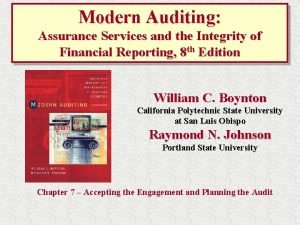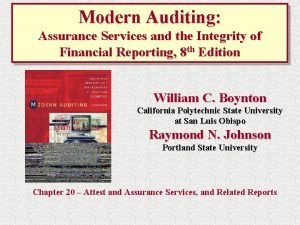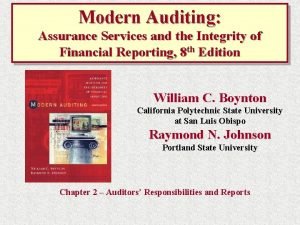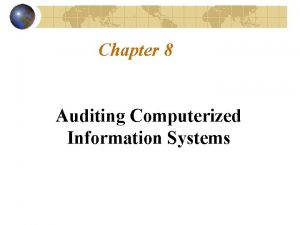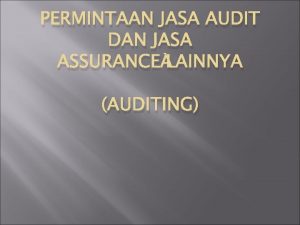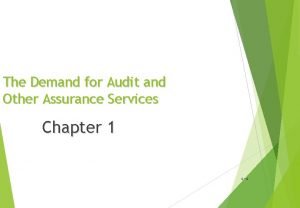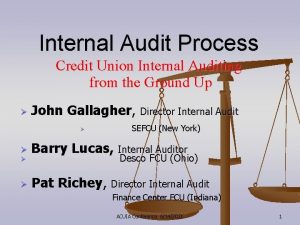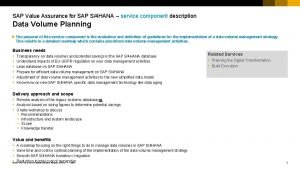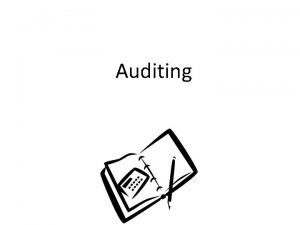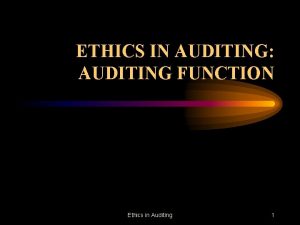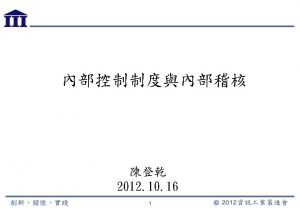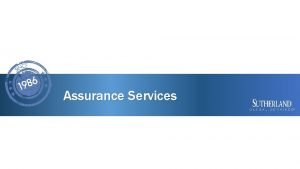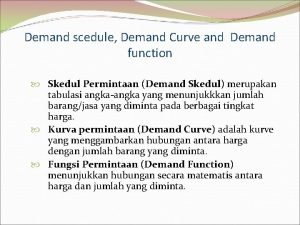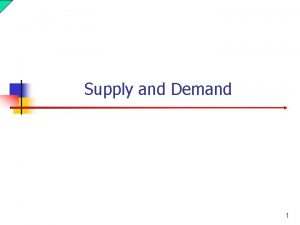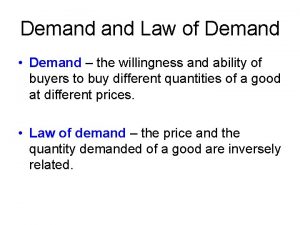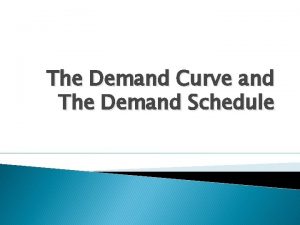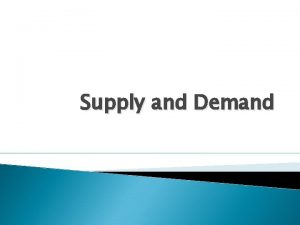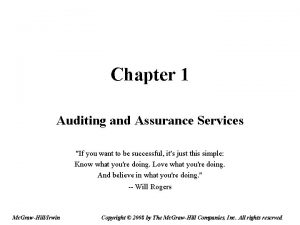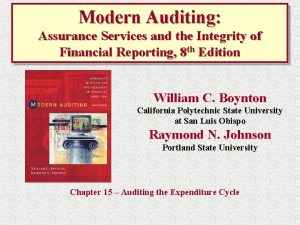Assurance Services The Demand for Auditing and Assurance






























- Slides: 30

Assurance Services

The Demand for Auditing and Assurance The development of the corporate form of business and the expanding world economy over the last 200 years have given rise to an explosion in the demand for the assurance provided by auditors.

The Demand for Auditing and Assurance A public company is a company that sells its stocks or bonds to the public, giving the public a valid interest in the proper use, or stewardship, over the company’s resources. Managers Stockholders Agents Principals

What Creates the Demand for Auditing and Assurance? • Audits lend credibility to information by reducing information risk, the risk that information is materially misstated • Financial statement misstatements arise due to-– – Accidental errors Lack of knowledge of accounting principles Unintentional bias Deliberate falsification • Audits do not directly address business risk, the risk that a company will not be able to meet its financial obligations due to economic conditions or poor management decisions

Forms of Audit and Attestation of Financial Statements 1 -5

Guiding Principles of Financial Statement Audits • • GAAP/IFRS GAAS SOX

Auditing Standards Auditing standards serve as guidelines for and measures of the quality of the auditor’s performance. PCAOB Auditing Standards Board Public Companies Nonpublic Companies

Sarbanes-Oxley Act • Public Company Accounting Oversight Board established • Audit Committee strengthened • Corporate reporting improved • Auditor independence redefined

Organizations Impacting Financial Statement Audits • • • FASB SEC AICPA PCAOB ASB

1 -10 Typical Structure of a National CPA Firm Partners Managers Seniors Staff Assistant

Responsibilities on an Engagement • Partner—Overall responsibility is to assure that audit is performed in accordance with professional standards. • Manager—Supervise overall engagement. • Seniors—”In charge” auditor on a daily basis • Staff assistants—Work under the immediate supervision of the senior

Categories of Public Accounting Firms • • Local Regional National Big 4

The Big Four • • Deloitte Ernst+Young KPMG Pricewaterhouse. Coopers

Types of Professional Services • • Audit, Attestation and Assurance Tax Consulting Accounting Personal Financial Planning Litigation Support Fraud Investigation

The Auditor’s Standard Report Board of Directors, Stockholders, Owners, and/or Management of ABC Company, Inc. 123 Main St. Anytown, Any Country • We have audited the accompanying financial statements of ABC Company, Inc. (a California corporation), which comprise the balance sheet as of December 31, 20 XX, and the related statements of income, retained earnings, and cash flows for the year then ended, and the related notes to the financial statements. • Management's Responsibility for the Financial Statements • Management is responsible for the preparation and fair presentation of these consolidated financial statements in accordance with U. S. generally accepted accounting principles; this includes the design, implementation, and maintenance of internal control relevant to the preparation and fair presentation of consolidated financial statements that are free from material misstatement, whether due to fraud or error. • Auditor's Responsibility • • Our responsibility is to express an opinion on these consolidated financial statements based on our audit. We conducted our audit in accordance with U. S. generally accepted auditing standards. Those standards require that we plan and perform the audit to obtain reasonable assurance about whether the consolidated financial statements are free from material misstatement. An audit involves performing procedures to obtain audit evidence about the amounts and disclosures in the consolidated financial statements. The procedures selected depend on the auditors' judgment, including the assessment of the risks of material misstatement of the consolidated financial statements, whether due to fraud or error. In making those risk assessments, the auditor considers internal control relevant to the entity's preparation and fair presentation of the consolidated financial statements in order to design audit procedures that are appropriate in the circumstances, but not for the purpose of expressing an opinion on the effectiveness of the entity's internal control. Accordingly, we express no such opinion. An audit also includes evaluating the appropriateness of accounting policies used and the reasonableness of significant accounting estimates made by management, as well as evaluating the overall presentation of the consolidated financial statements. We believe that the audit evidence we have obtained is sufficient and appropriate to provide a basis for our audit opinion. • Opinion • In our opinion, the financial statements referred to above present fairly, in all material respects, the financial position of ABC Company, Inc. as of December 31, 20 XX, and the results of its operations and its cash flows for the year then ended in accordance with U. S. generally accepted accounting principles. • • AUDITOR'S SIGNATURE Auditor's name and address

Unqualified • Unqualified opinion when financial statements “present fairly” – Financial position – Results of operations – Cash flows – Stockholders’ Equity

Qualified Opinions • Difference of opinion with management over application of GAAP that is material in amount • Nature of the difference

Adverse Opinion • Financial statements taken as a whole do not present fairly financial position or the results of operations or cash flows in conformity with GAAP • Preceded by a separate paragraph that provides all the substantive reasons for the auditor’s conclusion and principal effects of the subject matter on financial position, results of operation and cash flows

Disclaimer • Unable to gather sufficient evidence to warrant the expression of an opinion on the statements as a whole

Withdrawing from the Engagement • Significant conflict exists with management • Management cannot be trusted

Assumptions Underlying the Audit Report 1. Reasonable assurance 2. Materiality 3. Present fairly

Materiality • Magnitude of an omission or misstatement of accounting information that the judgment of reasonable person relying on the information would have been changed or influenced by the omission or misstatement

Judging Materiality • May not rely solely on a quantitative threshold as a “rule of thumb” to determine materiality • 5% is a common materiality test • Unintended consequence of materiality is that it is subject to manipulation • Full analysis of all relevant considerations • Consideration of risk of fraud

Present Fairly • Auditor’s assessment of fair presentation depends on whether 1. Accounting principles used have general acceptance 2. Accounting principles are appropriate 3. Financial statements are informative

Present Fairly 4. Information presented is classified and summarized in a reasonable manner 5. Financial statements reflect the underlying transactions and events in a manner that is consistent with materiality and reflects economic substance

Expectations Gap • Difference between – What the public and users of financial statements perceive as the responsibilities of accountants and auditors and – What accountants and auditors themselves see as their responsibilities

Error versus Fraud • Error – Innocent mistake in application of GAAP – Omission of information – Mathematical mistake • Fraud – Deliberate decision made to deceive another party

Techniques Used to Falsify Financial Information • • Lengthening estimated useful lives Special Purpose Entities (SPE) Bogus invoices to record revenue Backdated sales agreements Misapplication of GAAP Bill and Hold Channel Stuffing Others

Common Types of Fraud • • Theft of company assets Understate cash or other assets Overstate expenses “Bury” the expenses in an innocuous account Lapping of accounts receivable Theft of inventory Other

End of Auditing
 Modern auditing and assurance services
Modern auditing and assurance services Modern auditing and assurance services
Modern auditing and assurance services Modern auditing and assurance services
Modern auditing and assurance services Internal auditing assurance & advisory services
Internal auditing assurance & advisory services Auditing computer based information system
Auditing computer based information system Auditing standards differ from auditing procedures
Auditing standards differ from auditing procedures Perbedaan auditing dengan jasa assurance
Perbedaan auditing dengan jasa assurance Economic demand for auditing
Economic demand for auditing Module 5 supply and demand introduction and demand
Module 5 supply and demand introduction and demand Credit union internal auditing services
Credit union internal auditing services Deficient demand and excess demand
Deficient demand and excess demand Dependant demand
Dependant demand Demand schedule tagalog
Demand schedule tagalog Methods of demand estimation
Methods of demand estimation Paradox of value
Paradox of value Inventory models for independent demand
Inventory models for independent demand Deterministic demand vs stochastic demand
Deterministic demand vs stochastic demand Individual demand vs market demand
Individual demand vs market demand Dependent demand example
Dependent demand example Sap value assurance services
Sap value assurance services Digital assurance services
Digital assurance services Lqa quality assurance
Lqa quality assurance Digital assurance services
Digital assurance services Fspos
Fspos Novell typiska drag
Novell typiska drag Tack för att ni lyssnade bild
Tack för att ni lyssnade bild Returpilarna
Returpilarna Varför kallas perioden 1918-1939 för mellankrigstiden
Varför kallas perioden 1918-1939 för mellankrigstiden En lathund för arbete med kontinuitetshantering
En lathund för arbete med kontinuitetshantering Underlag för särskild löneskatt på pensionskostnader
Underlag för särskild löneskatt på pensionskostnader Tidbok
Tidbok
